中国组织工程研究 ›› 2019, Vol. 23 ›› Issue (19): 2991-2995.doi: 10.3969/j.issn.2095-4344.1181
• 肌肉肌腱韧带组织构建 tissue construction of the muscle, tendon and ligament • 上一篇 下一篇
低氧训练中过表达血红素加氧酶1促进小鼠骨骼肌线粒体的生物合成
赵延礼1,秦海兰1,崔 浩1,甘罗曼1,司立宁2
- (1青海大学基础医学研究中心,青海省西宁市 810016;2青海大学附属医院,青海省西宁市 810001)
Overexpression of heme oxygenase-1 promotes biosynthesis of skeletal muscle mitochondria during hypoxia training in mice
Zhao Yanli1, Qin Hailan1, Cui Hao1, Gan Luoman1, Si Lining2
- (1Basic Medical Research Center of Qinghai University, Xining 810016, Qinghai Province, China; 2Affiliated Hospital of Qinghai University, Xining 810001, Qinghai Province, China)
摘要:
文章快速阅读:
.jpg)
.jpg)
文题释义:
血红素加氧酶(heme oxygenase,HO):是血红素分解代谢过程中的限速酶,人体内的CO主要是由血红素氧化酶(HO)代谢产生的。HO有3种类型:氧应激诱导型(HO-1)、组成型(HO-2)及尚未明确的HO-3。血红素加氧酶1是体内重要的抗氧化酶,在很多系统具有促进线粒体生物合成的功能。
低氧训练:是在运动训练中持续或间断采用低氧条件刺激,利用高原自然低氧环境或人工模拟低氧环境对人体所产生的特殊生物学效应,配合运动训练来增加机体的缺氧程度,以调动体内的机能潜力,从而产生一系列有利于提高运动能力的抗氧生理反应及适应,进而达到提高运动成绩的目的。
血红素加氧酶(heme oxygenase,HO):是血红素分解代谢过程中的限速酶,人体内的CO主要是由血红素氧化酶(HO)代谢产生的。HO有3种类型:氧应激诱导型(HO-1)、组成型(HO-2)及尚未明确的HO-3。血红素加氧酶1是体内重要的抗氧化酶,在很多系统具有促进线粒体生物合成的功能。
低氧训练:是在运动训练中持续或间断采用低氧条件刺激,利用高原自然低氧环境或人工模拟低氧环境对人体所产生的特殊生物学效应,配合运动训练来增加机体的缺氧程度,以调动体内的机能潜力,从而产生一系列有利于提高运动能力的抗氧生理反应及适应,进而达到提高运动成绩的目的。
摘要
背景:近年对低氧训练机制的研究主要围绕低氧训练对机体血液系统的调节作用展开,但结果具有两面性,提示还有非血液系统调节机制。
目的:探讨血红素加氧酶1在低氧训练中对小鼠骨骼肌线粒体含量及生物合成的调节作用。
方法:SPF 级8周龄雄性过表达血红素加氧酶1转基因小鼠20只,野生型小鼠20只,由兰州大学医学院提供。2种小鼠分别被随机分为2组(共4组):野生小鼠低氧静息组、野生小鼠低氧训练组、转基因小鼠低氧静息组和转基因小鼠低氧训练组。低氧训练组小鼠在青海大学基础医学研究中心进行跑台运动(速度 20 m/min,坡度5°,60 min/d,5 d/周,共4周)。各组小鼠均于末次训练结束3 d后行速度20 m/min,坡度5°持续跑台运动并记录各组小鼠力竭运动时间,电镜检测骨骼肌线粒体数量,JC-1荧光探针检测线粒体膜电位,萤光素酶发光法检测线粒体ATP合成活性,Western blot检测骨骼肌血红素加氧酶1、COX IV和PGC-1α蛋白表达量。
结果与结论:①与野生小鼠低氧静息组相比,野生小鼠低氧训练组和转基因小鼠低氧训练组力竭运动时间增加,线粒体数目略有增多,线粒体膜电位和ATP合成增加,血红素加氧酶1、COX IV和PGC-1α蛋白表达量增加;②与野生小鼠低氧训练组相比,转基因小鼠低氧训练组力竭运动时间明显增加,线粒体数目显著增多,线粒体膜电位和ATP合成增加,COX IV和PGC-1α蛋白表达量显著增加;③结果说明,血红素加氧酶1在低氧训练中具有延长小鼠力竭运动时间的作用,其机制可能与增加骨骼肌线粒体数量和生物合成有关。
中国组织工程研究杂志出版内容重点:组织构建;骨细胞;软骨细胞;细胞培养;成纤维细胞;血管内皮细胞;骨质疏松;组织工程
ORCID: 0000-0001-6786-8910(赵延礼)
背景:近年对低氧训练机制的研究主要围绕低氧训练对机体血液系统的调节作用展开,但结果具有两面性,提示还有非血液系统调节机制。
目的:探讨血红素加氧酶1在低氧训练中对小鼠骨骼肌线粒体含量及生物合成的调节作用。
方法:SPF 级8周龄雄性过表达血红素加氧酶1转基因小鼠20只,野生型小鼠20只,由兰州大学医学院提供。2种小鼠分别被随机分为2组(共4组):野生小鼠低氧静息组、野生小鼠低氧训练组、转基因小鼠低氧静息组和转基因小鼠低氧训练组。低氧训练组小鼠在青海大学基础医学研究中心进行跑台运动(速度 20 m/min,坡度5°,60 min/d,5 d/周,共4周)。各组小鼠均于末次训练结束3 d后行速度20 m/min,坡度5°持续跑台运动并记录各组小鼠力竭运动时间,电镜检测骨骼肌线粒体数量,JC-1荧光探针检测线粒体膜电位,萤光素酶发光法检测线粒体ATP合成活性,Western blot检测骨骼肌血红素加氧酶1、COX IV和PGC-1α蛋白表达量。
结果与结论:①与野生小鼠低氧静息组相比,野生小鼠低氧训练组和转基因小鼠低氧训练组力竭运动时间增加,线粒体数目略有增多,线粒体膜电位和ATP合成增加,血红素加氧酶1、COX IV和PGC-1α蛋白表达量增加;②与野生小鼠低氧训练组相比,转基因小鼠低氧训练组力竭运动时间明显增加,线粒体数目显著增多,线粒体膜电位和ATP合成增加,COX IV和PGC-1α蛋白表达量显著增加;③结果说明,血红素加氧酶1在低氧训练中具有延长小鼠力竭运动时间的作用,其机制可能与增加骨骼肌线粒体数量和生物合成有关。
中国组织工程研究杂志出版内容重点:组织构建;骨细胞;软骨细胞;细胞培养;成纤维细胞;血管内皮细胞;骨质疏松;组织工程
ORCID: 0000-0001-6786-8910(赵延礼)
中图分类号:
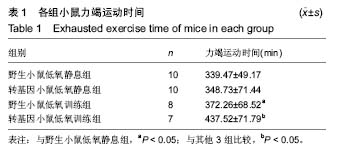
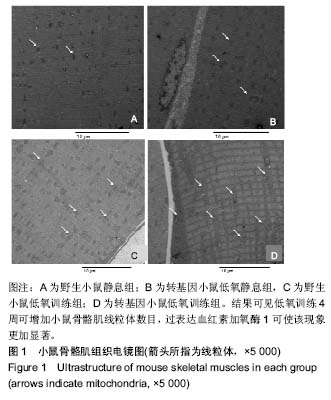
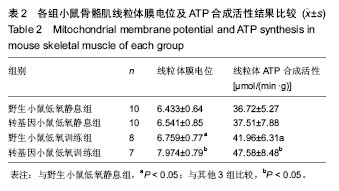
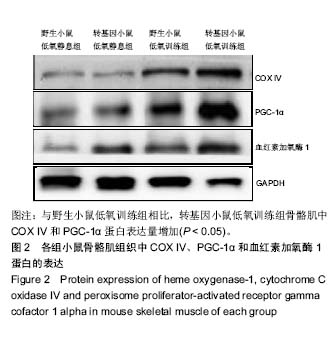
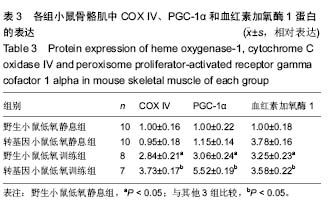
.jpg)